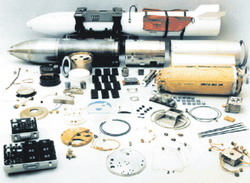
Defense Programs
One of the primary missions of NNSA is to maintain and enhance the safety, security and reliability of the U.S. nuclear weapons stockpile. NNSA, through its Office of Defense Programs, ensures that the U.S. nuclear arsenal meets the country’s national security requirements and continues to serve its essential deterrence role. In partnership with the Department of Defense, NNSA’s Defense Programs provides the research, development, secure transportation, and production activities necessary to support the U.S. nuclear weapons stockpile.
 Following the end of the Cold War, the United States discontinued production of new nuclear warheads and voluntarily ended underground nuclear testing. Today, NNSA uses and oversees a wide-range of breakthrough science experiments, engineering audits and high-tech computer simulations, including extensive laboratory and flight tests of warhead components and subsystems, to keep the existing warheads reliable, secure and safe. Every year, the Secretary of Energy is able to certify the reliability of the stockpile without conducting an underground nuclear test. NNSA’s use of science-based research and development in the absence of underground nuclear testing in order to maintain the Department of Energy’s portion of the nation’s nuclear deterrent is known as the Stockpile Stewardship Program. Following the end of the Cold War, the United States discontinued production of new nuclear warheads and voluntarily ended underground nuclear testing. Today, NNSA uses and oversees a wide-range of breakthrough science experiments, engineering audits and high-tech computer simulations, including extensive laboratory and flight tests of warhead components and subsystems, to keep the existing warheads reliable, secure and safe. Every year, the Secretary of Energy is able to certify the reliability of the stockpile without conducting an underground nuclear test. NNSA’s use of science-based research and development in the absence of underground nuclear testing in order to maintain the Department of Energy’s portion of the nation’s nuclear deterrent is known as the Stockpile Stewardship Program.
NNSA’s nuclear weapons activities are carried out in a nationwide complex of government-owned, contractor-operated national security laboratories, test site, and nuclear weapons production sites. These sites, collectively known as NNSA’s nuclear weapons complex, provide the necessary research, development and production capabilities needed to maintain the reliability, security and safety of the weapons stockpile.
Part of keeping the U.S. nuclear weapons stockpile safe and reliable includes working with the Department of Defense to maintain the quantity and quality of weapons necessary for U.S. national security needs. Under the Moscow Treaty between the United States and Russia, the United States agreed to reduce the size of its operationally deployed nuclear weapons down to between 1,700 to 2,200 by 2012. In addition to this treaty, President Bush directed in 2004 that the size of the overall nuclear weapons stockpile (both reserve and operationally deployed) be reduced nearly 50 percent by 2012. This goal was met in 2007 - five years early. This allowed President Bush to direct that an additional reduction of nearly 15 percent take place by 2012. As a result of these actions, the stockpile is the smallest it has been since the Eisenhower administration. NNSA’s Defense Programs is actively working to meet the reduced stockpile quantity levels by safely dismantling and disposing of those nuclear weapons that have been designated in excess of U.S. national security needs.
In addition to maintaining the actual weapons, NNSA is also focused on the security and safety of the weapons. Robust security protects weapons and weapons material both at each facility and through securely transporting materials and weapons between facilities and military locations. NNSA also strives to conduct operations in ways that that are safe for the environment and the public.
As threats against the country evolve and become more and more unpredictable, and especially as the current weapons in the U.S. nuclear stockpile age and become increasingly difficult and expensive to maintain, NNSA is working now to transform itself and revitalize the entire nuclear weapons complex to be smaller, safer, more secure and more efficient. NNSA must be better able to quickly respond to technical problems in the stockpile and be able to rapidly respond to unforeseen national security needs. Click here to learn more about NNSA’s transformation efforts.
|
 |